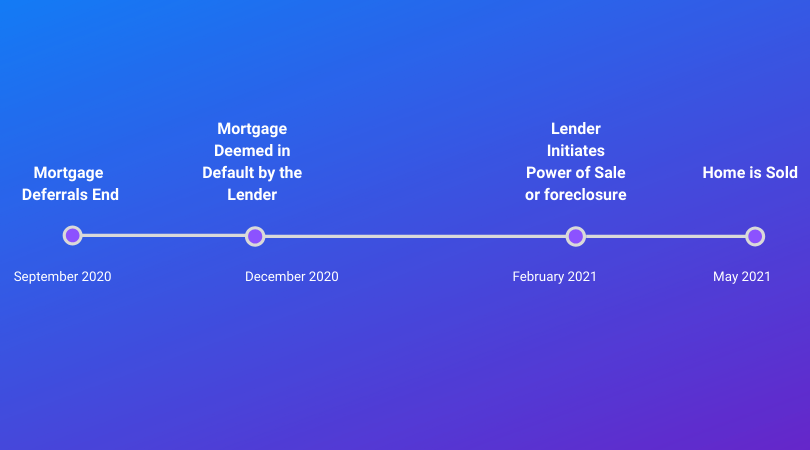The Upcoming Mortgage Deferral Cliffs of Doom
The media seems to either proclaim that home prices will skyrocket or drop; with very little in between. The latest buzzword is the “Mortgage Deferral Cliff”, which refers to a wave of people that opted for mortgage deferral payment plans in early 2020 that will then default once their 6-month mortgage deferral period is up at the end of the summer. This has sparked speculation amongst potential buyers (and industry players) that it will result in massive buying opportunities at the end of the deferral cliff. At Perch, we don’t believe that this cliff will have any material effect on the housing market.
How Big Is The Possible Issue?
The Canadian Bankers Association has estimated that roughly 15% of Canada’s largest bank’s mortgage portfolios are on mortgage deferral plans. Similarly, the CMHC has estimated that 12% of insured mortgages across Canada are on payment deferral plans. If we take the mid-point of the two and assume 13.5% for simplicity, how many homes would this impact?
There are around 15M homes in Canada. According to the latest StatsCan Census data, roughly 60% of them have mortgages. That works out to about 9M homes with mortgages. With the assumption that 13.5% are on deferral plans, then 1.22M homes should be reaching the mortgage deferral cliff roughly 1-2 months from now.
How Big Is The Actual Issue?
While no data is available to tell us exactly who the groups of people using mortgage deferrals are, we believe that the majority are people who purchased a home within the last 2 years, with a greater skew towards first-time home buyers. Here’s why:
- CMHC data outlines that 90% of their mortgage deferrals are those with 5-15% equity in the property. This would predominantly be new buyers since the minimum downpayment is 5-7.5% and borrowers on average pay off around 6% of their mortgage balance per year through their regular mortgage payments and prepayments.
- According to Mortgage Professionals Canada, roughly 725,000 homes are sold each year in Canada (of which 300,000 are first-time home buyers).
- On top of having the largest mortgage balances, the new buyer demographic was most likely to be impacted by the large layoffs in March-April 2020. The unemployment rate for Canadian millennials increased from 5.5% to 12.6% between February 2020 and April 2020. This demographic accounts for roughly 53% of first-time buyers and 40% of all buyers.
Before COVID, 23% of home buyers in CMHC’s consumer survey said their current debt levels were higher than expected and around 7% of buyers were having difficulty making ends meet due to their mortgage payments. Assuming the impact on buyers is in line with the impact on the unemployment demographic, that would imply 16% of buyers within the last 2 years (232,000 homes using our volume data above to estimate) can’t make ends meet.
So why is there such a huge gap between the estimated 1.22M homes that are supposedly heading towards the cliff when our estimate is just 0.23MM?
Better Safe Than Sorry
According to the CBA, 90% of mortgage deferral applications submitted were accepted. When you combine relaxed thresholds and a survival mentality during a crisis, those who believe all people opting for a mortgage payment deferral are going to default lack faith in a Canadian’s ability to weather the storm! Deferring mortgage payments isn’t something any borrower takes lightly, but it’s clear that people prefer keeping their options open. Especially when we’re living in uncertain times.
Lenders already offer the “skip a mortgage payment” feature as a perk on some mortgages because borrowers like having the option to defer payments for one month. It’s not hard to imagine that some borrowers might then also appreciate the option of a six-month deferral.
Simultaneously, the same question that motivates someone to buy 200 rolls of toilet paper or a full skid of canned meat drives them to sign up for mortgage deferrals: “If I don’t get it now, will it still be there if I need it later?”. Deferring payments isn’t free – the cost is interest owed in the future on those deferred payments. But with mortgage rates so low, that is a small cost to pay to get peace of mind as it relates to protecting your home during a crisis from default.
The numbers tell a similar story: According to the CBA, 10% of bank portfolios were put on mortgage deferrals in March alone, but by the end of May that amount only rose to 15% and remained flat at 15% into June, which is a significant deceleration.. As Lysol wipes begin reappearing in grocery stores, people have simultaneously opted for mortgage deferrals at a much slower pace.
What About The Cliff?
For those that have lost their jobs and weren’t able to find new employment within 6 months, have no savings or credit lines to lean on, have no equity to pull out of the home or who can’t get any funds from friends/family; that mortgage deferral cliff will be a real concern and could be financially devastating. Being forced to sell your home is never a good situation, especially if you’re forced to sell at a lower price than you purchased it.
We believe this will be the case for less than 2% of Canadian mortgage holders (180,000 homes), not the full 13.5% on mortgage deferrals. Keep in mind that around 725,000 homes were sold last year and new construction homes were expected to slow during the crisis. Thus, the increased supply of homes for sale in the event of a default will be partially offset by lost inventory due to new builds being delayed/cancelled. This means large decreases in home prices are unlikely.
Furthermore, you wouldn’t have the ability to buy any of those properties for quite some time. Let’s go through an example with someone who’s mortgage deferrals are ending September 2020. They would then need to miss 3 more months of payments before being deemed in default by the lender (since mortgage deferrals don’t count towards default). Most lenders will then try to find a way to work with the borrower if possible, since selling your home is rarely their desired outcome. This back and forth could take another month until the lender takes further action if no agreement is reached. From there, the lender would initiate a power of sale (which takes around 2 months) or foreclosure (which takes around 9 months) before the home is listed on the market. This means that your “bargain purchase” that was supposed to hit the market in September 2020 likely won’t sold until May 2021 or later. Sorry to burst your bubble.
No Fire Sale?
You may still wind up getting a good deal, just not the way you thought. According to CMHC, home prices are expected to fall over the next year between 9-18% and aren’t expected to recover for at least 1 year. So while cliff diving is likely out of the picture, there’s still an adventure waiting for you if those forecasts turn out to be true.
Sign up for Perch to get a free home buying plan and get pre-approved so you’re ready to move when the right opportunity presents itself.
 Alex
Alex






